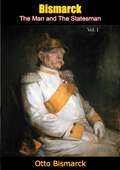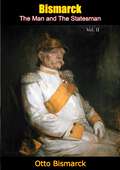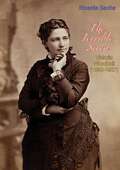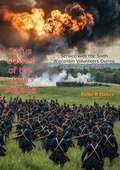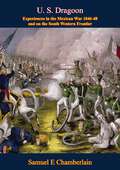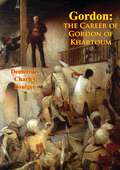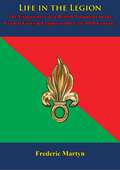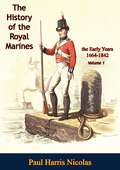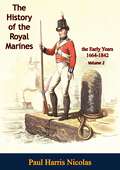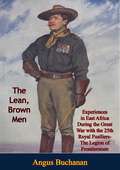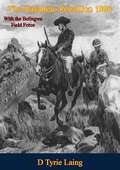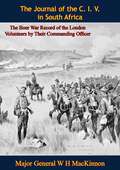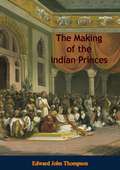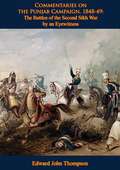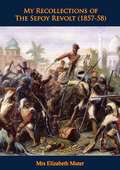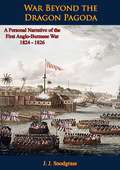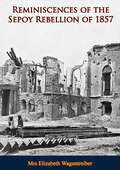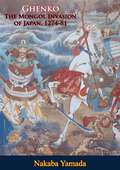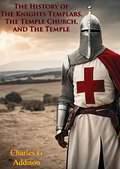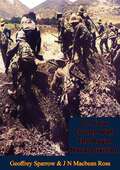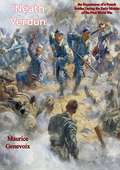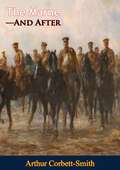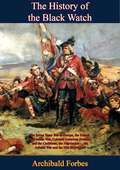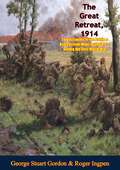- Table View
- List View
Bismarck: The Man and The Statesman Vol. I (Bismarck: The Man and The Statesman #1)
by Otto Bismarck"Politics is the art of the possible," Otto Von Bismarck famously said, and here, in his own words, the art of politics is laid bare by one of the most prominent and influential European statesmen of the nineteenth century. These are the intimate reflections and reminiscences of the man who unified the independent Germanic states into one nation, and whose subsequent promotion of the new country's colonial ambitions earned him the title of the founder of the German empire. This first volume of what must be considered an essential historical document details Bismarck's early life, from the political views of his youth and his entrance into public life through his work in government ministries and his time at the Court of Munich. It is vital reading for any informed, in-depth understanding of modern European history.-Print ed.
Bismarck, The Man and The Statesman Vol. II (Bismarck: The Man and The Statesman #2)
by Otto Bismarck"Politics is the art of the possible," Otto Von Bismarck famously said, and here, in his own words, the art of politics is laid bare by one of the most prominent and influential European statesmen of the nineteenth century. These are the intimate reflections and reminiscences of the man who unified the independent Germanic states into one nation, and whose subsequent promotion of the new country's colonial ambitions earned him the title of the founder of the German empire. This first volume of what must be considered an essential historical document details Bismarck's early life, from the political views of his youth and his entrance into public life through his work in government ministries and his time at the Court of Munich. It is vital reading for any informed, in-depth understanding of modern European history.-Print ed.
Bamie: Theodore Roosevelt's Remarkable Sister
by Lilian RixeyTheodore Roosevelt’s daughter Alice Roosevelt Longworth once remarked that if her “Auntie Bye” had been a man, she would have been the president.Anna Roosevelt Cowles was Theodore Roosevelt’s older sister by almost four years. She was nicknamed Bamie as a child. Her siblings, nieces, and nephews later called her “Auntie Bye” because she was always on the go.After overcoming a childhood disability, Bamie grew into a tower of strength for her immediate family and supported them throughout her life, especially after her father passed away. She also assisted her extended family at every opportunity.Throughout his life, Bamie was Theodore’s close confidante and political advisor, as well as a guiding force to other family members and friends. She was the only family member to encourage Theodore to enter politics. She planned her brother's political campaigns with Cabot Lodge and other Washington luminaries.She used her charm, perceptive judgment, and extensive contacts on both sides of the Atlantic to promote TR and his policies while and after she served as an unofficial ambassador to England.In Washington, Anna hosted regular luncheons and parties to help Theodore meet people and discuss issues with them. In fact, while he was president, Theodore was so often at his sister’s DC home that it was referred to as “the other White House”. He wrote her weekly letters, explaining he needed her help in clarifying his thoughts.Anna was a history-maker in her own right, helping to establish the US Army’s corps of nurses.Author Lillian Rixey was the grand-niece of TR’s White House physician and a journalist who was given access to unpublished material including a memoir that Bamie wrote for her son.This sparkling biography overflows with personal writings from the close-knit Roosevelt family and quotes from journalists and significant historical figures.
The Terrible Siren: Victoria Woodhull (1838-1927)
by Emanie SachsAs Publishers Weekly noted, “No heroine of any romance ever had a more adventurous career than this unvictorian Victoria.”In Victoria Woodhull’s prime during the mid to late 1800s, women were not allowed to vote, were not encouraged to run a business, and certainly did not speak of free love, much less get divorced. Women endured other ridiculous conventions, like not being seen outside a home after dark without an escort. Restaurants refused to serve single women after 6pm.Victoria Woodhull smashed all these conventions and many more. She married for the first time while only 15 years old. She was married at least 3 times, with 2 divorces.Victoria held seances for Cornelius Vanderbilt to give him tips. With his mentorship, she, along with Tennessee, her equally beautiful sister, opened their own stock brokerage firm and were the first female brokers on Wall Street. One reviewer said it was a time “when a woman in business was as great a novelty as an elephant in a balloon.”The sisters ran a weekly newspaper in New York that ardently advocated for free love. Anthony Comstock sent them to jail for the contents of that paper.Victoria was a skillful orator who pushed for women’s equality, especially suffrage. One reviewer stated, “Audiences came to denounce her and stayed to acclaim her.”She was the first woman to be nominated for President of the United States by a political party. She ran in 3 different elections.She was the first woman to receive an official hearing before a congressional committee, when she presented a memorial about woman suffrage.Victoria unapologetically sought the spotlight and practiced what she preached despite notoriety and persecution.
Rufus Dawes of the Iron Brigade: [Illustrated Edition]
by Rufus R DawesIncludes Civil War Map and Illustrations Pack - 224 battle plans, campaign maps and detailed analyses of actions spanning the entire period of hostilities.“With the Iron Brigade on campaign and battlefieldFor students of the American Civil War, the name Rufus Dawes will be forever associated with the famous Iron Brigade of the Union Army—that hardy and courageous assembly of regiments from the western states whose steadfastness in the thickest of battlefield conflicts earned them their descriptive nickname. Born in 1838, Dawes was just 23 years old when the Civil War broke out and he became a captain in the 6th Wisconsin Volunteer Infantry, the regiment he would, in time, come to famously command. Dawes was always an ardent and aggressive battlefield commander. He served with the regiment at Groveton, Antietam, Fredericksburg and through the Chancellorsville campaign. At Gettysburg he notably led the counter-attack on Davis's Confederate brigade sheltering in a railway cutting and there took some 200 prisoners. Dawes served at Mine Run, the Wilderness Campaign, the sieges of Petersburg and Spotsylvania and Cold Harbor in 1864. Worn out physically and mentally, Dawes was mustered out after three years of the most intensive combat—he was just 26 years old. The following year he was promoted to brevet brigadier general. This book, Dawes' own account of his regiment of 'Black Hats' of the Iron Brigade, is an acknowledged classic of the period.”-Print ed.
U. S. Dragoon: Experiences in the Mexican War 1846-48 and on the South Western Frontier
by Samuel E Chamberlain“From soldier to wagon master to scalp hunterChamberlain left Boston as a mere youth and joined the United States Army. He became a soldier in the 1st US Dragoons and determined to become the very ideal of the daring cavalryman both on and off the battlefields of the American-Mexican War. His is a tale—not a little tall—that includes accounts of passionate love affairs, duels to the death, pitched battles and exploits of daring in which Chamberlain himself features as the central heroic figure. Certainly he was a larger than life character, as his accounts of constant troubles with his superiors for brawling, drunkenness and insubordination appear with a detail and frequency which suggest authenticity. At the end of the war Chamberlain became a wagon master—possibly after deserting the army—and then threw himself into a series of adventures with a notorious band of scalp hunters led by the infamous John Glanton. A highly entertaining and informative account of the United States cavalry at war, in which many of the principal characters of the American Civil War—who appear within its pages—learned their craft.”-Print ed.
Gordon: the Career of Gordon of Khartoum
by Demetrius Charles Boulger“A great British soldierThis is the biography of one of the most famous soldiers of the Victorian age—Major-General Charles Gordon. Certainly he is now known as Gordon of Khartoum, but highly regarded in his own lifetime, he was to many also Chinese Gordon and Gordon Pasha. Commissioned as a Royal Engineer, Gordon first saw action during the Crimean War taking part in the siege of Sebastopol, the assault on the Redan and the expedition to Kinburn. In 1860 the Second Opium War broke out in China and it was here and during the Taiping Rebellion that Gordon earned his reputation and the recognition that set him towards high military rank. But it was Africa where he achieved his greatest fame. Gordon was engaged in much vital and interesting service before he found himself behind the walls of Khartoum in an unequal struggle against the religious fervour of the Mahdist forces. This is a thorough account of the man and his times which will be of great interest to those who wish to learn more about Gordon than just his martyrdom in the Sudan.”-Print ed.
Life in the Legion: The Experiences of a British Volunteer in the French Foreign Legion in the Late 19th Century
by Frederic MartynOn campaign under the tricolor“This is an essential book for all those interested in the French Foreign Legion because it is a brilliant first hand account written by an English 'gentleman volunteer' who experienced 'life in the legion' in the late 1880's and who had previously been a serving officer in one of the cavalry regiments of the British Army. Far from being a tale of hardship and abuse, the author had nothing but admiration for the Legion and—as an experienced soldier—obviously thoroughly enjoyed the five years he spent serving in its ranks. The writer quite simply could not have enough action and he volunteered to serve in Tonkin, Dahomey and against the Tuareg tribesmen of North Africa. In consequence this book is full of colourful and detailed campaign and battle action which is compellingly recounted by a fighting soldier more than capable of putting his engrossing story into words. Highly recommended.”-Print ed.
The History of the Royal Marines: The Early Years 1664-1842: Volume 1 (The History of the Royal Marines: the Early Years 1664-1842 #1)
by Paul Harris Nicolas“The first volume of a two volume anniversary history of the early Royal Marines.The Royal Marines can trace their origins back to the formation of 'The Duke of York and Albany's Maritime Regiment of Foot' in 1664…The Royal Marines as we know them today were formed in 1755 and since that time they have distinguished themselves in many conflicts fought by the British to the present day. Numerous books have been written about the exploits of the Royal Marines, particularly in the 20th century, but this special two volume edition concentrates on the earliest period of their history. The presence of red-coated marines was inseparable from the blue uniform of their naval comrades during the great age of sail and this book covers that period in detail including the American War of Independence. The great contest of the early 19th century was against Revolutionary, Consulate and Napoleon Bonaparte's First Empire of the French. The Royal Marines fought in every major naval engagement of that long war, all of which are detailed in these pages together with many minor engagements, the War of 1812 and the imperial campaigns including the Chinese Opium Wars.”-Print ed.
The History of the Royal Marines: The Early Years 1664-1842: Volume 2 (The History of the Royal Marines: the Early Years 1664-1842 #2)
by Paul Harris Nicolas“The first volume of a two volume anniversary history of the early Royal Marines.The Royal Marines can trace their origins back to the formation of 'The Duke of York and Albany's Maritime Regiment of Foot' in 1664…The Royal Marines as we know them today were formed in 1755 and since that time they have distinguished themselves in many conflicts fought by the British to the present day. Numerous books have been written about the exploits of the Royal Marines, particularly in the 20th century, but this special two volume edition concentrates on the earliest period of their history. The presence of red-coated marines was inseparable from the blue uniform of their naval comrades during the great age of sail and this book covers that period in detail including the American War of Independence. The great contest of the early 19th century was against Revolutionary, Consulate and Napoleon Bonaparte's First Empire of the French. The Royal Marines fought in every major naval engagement of that long war, all of which are detailed in these pages together with many minor engagements, the War of 1812 and the imperial campaigns including the Chinese Opium Wars.”-Print ed.
The Lean, Brown Men: with the 25th Royal Fusiliers-The Legion of Frontiersmen
by Angus Buchanan“Lean men, brown men, men from overseas,Men from all the outer world; shy and ill at easeThere were Canadian Mounties, American cowboys, Arctic explorers, adventurers, rogues, big game hunters and sportsmen. There were famous men like Cherry Kearton, the naturalist and explorer and the grand old man of Africa—Frederick Selous himself. All these men had come together under the Union Flag to do battle against colonial Imperial Germany in East Africa. They came under the command of Driscoll of Driscoll's Scouts who performed with renown during the Boer War. These were the men of the 25th Royal Fusiliers—The Legion of Frontiersmen—and their battlegrounds were to be the great plains of Africa rich in wildlife and elemental danger. This is their story through the years of the Great War told by one of their own officers in vivid detail. It is a story of campaigns and hardship which would be equal to the best of them and lay many a 'lean, brown man' in a shallow grave in the red earth before it was concluded.”-Print ed.
The Matabele Rebellion 1896 With the Belingwe Field Force: With The Belingwe Field Force (classic Reprint)
by D Tyrie Laing“The struggles for AfricaThere can be few more interesting and evocative periods of British imperial history than the struggles for south-eastern Africa. The empire had found itself colliding with the interests of many native powers across the globe during the decades of its expansion. Many had fought to maintain their independence and some, like the Sikhs of the Punjab, were sufficiently well versed in the practice of warfare as to be a serious threat. This could not be said of the tribes which rose from the Zulu nation, yet the Zulu War of 1879 gave British forces a chilling and brutal lesson in what a 'primitive' African tribal army was capable of achieving on the field of battle. The Matabele, as an off-shoot of the martial Zulus, also inevitably came into conflict with the British during the closing decade of the 19th century. The First Matabele War did not decisively subjugate the tribe and in 1896 it rose again laying siege to Bulawayo with over 10,000 Ndebele warriors.”-Print ed.
The Journal of the C. I. V. in South Africa: The Boer War Record of the London Volunteers by Their Commanding Officer
by Major General W H MacKinnon“London men at war against the BoersThe turn of the 19th century to 20th was a time of popularity for the military volunteer movement in the British Empire. When the Anglo-Boer War broke out the City Imperial Volunteers quickly filled its ranks with the men of the City of London anxious to serve their country in South Africa. The venture was supported by the Lord Mayor and the popularity of London's effort had widespread appeal. All manner of men hurried to join the C. I. V's ranks and many of them were professionals from the city's law firms and financial institutions, artists, writers or gentlemen of private means. The author of The Riddle of the Sands, Erskine Childers was one of their number. This book is comprised of the journal entries of the officer commanding the regiment and it follows the C. I. V's wartime experiences from recruitment to its return home. The C. I. V was well regarded on campaign and earned the praise of peers and senior officers alike. This book delivers its information in the sober manner one might expect of its author in the circumstances, but is nevertheless essential source material about each part of the unit-the infantry, mounted infantry, cyclists, medical staff etc. Included as an appendix is a substantial honour role that will be of special interest to genealogists.”-Print ed.
The Making of the Indian Princes
by Edward John ThompsonIndia’s political framework was made in twenty years: in 1799-1819, between the death of Tipu Sultan and the elimination of the Peshwa. The period opens with the destruction of the Muslim kingdom of Mysore and ends with the disintegration of the Maratha Confederacy into a series of separate chieftaincies. These two conquests gave the British the control of India.After Tipu’s destruction the Marathas remained. When they were finally beaten down, Modern India was formed and its map in essentials drawn. The arrangement was to stay until the slow process of time and the coming of new systems of political thinking made it an anachronism, calling for Round Table Conferences, White Papers, and their sequel in constitutional legislation and political offers. India, as we knew it yesterday and the world has known it, was made in the space of these twenty years, first by the shattering of what Lord Wellesley styled ‘the Mahratta Empire’ and then, after a brief period of uncertain and faltering doctrine, by Lord Hastings’ firm establishment of the States which had survived, each in the niche and status which was to be legally accepted as its own until our day. The Indian ‘Prince’ emerged in 1806, arising, like the Puranic Urvasi, from the churning of the Ocean by the Gods and Demons, and received his position in India’s polity in 1819.
Commentaries on the Punjab Campaign, 1848-49: the Battles of the Second Sikh War by an Eyewitness
by James Henry Lawrence-Archer“An infantry officer's view of the fall of the Sikhs.The author of this book served with No 6 company of HM 24th Regiment-an infantry regiment of the British Army-which saw much service in the Second Sikh War and suffered greatly in the fighting particularly at Chillianwalla. So there could hardly be a more qualified writer—or one with closer connections to other participants—to take on the task of reporting the war. At the conclusion of the First Sikh War there remained a sense of business unfinished. The Sikhs were yet masters of the Punjab and the Khalsa remained one of the most formidable armies the Sub-Continent had ever seen. Most importantly the centre of Sikh power, the seemingly impregnable and daunting fortress of Mooltan remained defiant. Once again the British Empire learnt the lesson of what a formidable foe the Sikhs were as they joined battle with them at Ramnuggar, Chillianwalla, Mooltan and Googerat. Archer takes us through this campaign in compelling detail embellished by an insight only first hand experience can provide.”-Print ed.
My Recollections of The Sepoy Revolt (1857-58)
by Mrs Elizabeth Muter“Mrs Elizabeth McMullin Muter was married to a captain of the 1st Battalion 60th King's Royal Rifles stationed in Meerut, a few hours travel east of Delhi, when the mutiny among the sepoys of the garrison broke out there on Sunday morning of May 10th, 1857. Elizabeth Muter graphically describes the horrors of those first days of the conflict from the perspective of the wives of officers who were set adrift in times of peril and uncertainty as their husbands left them to fight. This book also contains some campaign recollections by Captain Muter.”-Print ed.
War Beyond the Dragon Pagoda: A Personal Narrative of the First Anglo-Burmese War 1824 - 1826
by J. J. Snodgrass“The author—a staff officer—who was an eyewitness to most of the major events of the First Anglo-Burmese War, gives us an incisive overview of the whole war. This provides the reader with a unique insight into the actions of the various troops during the course of the campaign. However it is the author's descriptions of pitched battles against a richly caparisoned foe—including everything from umbrella bearing generals and war elephants to "invincibles" and Amazons—that bring this exotic and spectacular conflict vividly to life. Re-living this war from just one step away, whether witnessing fighting in jungle stockades or experiencing river actions against Burmese war boats, will remain with and intrigue all who are interested in the British in the East.”-Print ed.
Reminiscences of the Sepoy Rebellion of 1857
by Mrs Elizabeth Wagentreiber“Elizabeth Wagentreiber was the youngest daughter of Colonel James Skinner of the famous cavalry regiment 'Skinner's Horse'. She had originally married a Captain Radclyffe Haldane, an officer of Skinner's Horse who was killed at the Battle of Chillianwallah during the Second Anglo-Sikh War. She subsequently married George Wagentreiber. And in the Spring of 1857 the couple were living in the civilian lines at Delhi when the Indian Mutiny broke out in the Bengal Army and reports arrived that the native cavalry was running amok in the city, slaughtering Europeans. Fearful for their lives the couple escaped with their children and the harrowing account of their time as fugitives makes compelling reading.”-Print ed.
Ghenko: The Mongol Invasion of Japan, 1274-81
by Nakaba Yamada“A ferocious conflict between Mongol and Samurai.The Japanese word 'Ghenko' is the term employed for the Mongol invasion of Japan. The event was an immensely significant one for the Japanese and it remained so for centuries because, in part, the defeat of the invaders was attributed to divine intervention. There can be little doubt that Japan's salvation had much to do with the fact that they are an island race and in that they have much in common with other islanders, Great Britain among them, who on more than one occasion might claim the sea as their principal and most powerful ally. Indeed, the author of this book draws parallels with Britain and the Spanish Armada. The Mongols had rapidly risen to power during the 13th century and had created an unstoppable empire that spread over huge areas of land from the Yellow Sea of Asia to the Danube in Europe. Although massively stronger than the Japanese, the Mongols attacked the Japanese islands, attempting domination by invasion and yet were repulsed with finality. To modern students of military history the contents of this book has a compelling allure, since there can be no doubt that in the Mongol warrior and the Japanese Samurai there resided a martial spirit and expertise which, perhaps inevitably, could not both exist in the same sphere, but which in collision could not fail to instigate conflict of the most singular kind. This account of the clash between the ultimate warriors of their day analyses this time of warfare in superb detail. An essential addition to the library of anyone interested in the warfare of the East.”-Print ed.
The History of The Knights Templars, The Temple Church, and The Temple: Large Print
by Charles G Addison“The warrior knights of the crossThe Knights Templar were one of the most famous Christian military orders of the medieval period. Officially endorsed by the church in the early decades of the 12th century the express purpose of the order was to provide defence and protection to Christian pilgrims. The concept became a popular one and with patronage came wealth and power so that the order, through a substantial infrastructure of non-warrior members spread throughout Europe promoting its objectives, developing financial institutions and building fortification on a grand scale. However, the Knights Templar are especially remembered today for the prowess of their military knights. Clad in white mantles bearing the distinctive red cross the Templars both attracted and created some of the most expert and effective fighting men of their time. Naturally, the order was closely connected to the Holy Land and with the Crusades. For some two hundred years it fought the forces of Islam for dominance of Jerusalem experiencing mixed fortunes in dozens of actions and major battles. The eventual loss of the Holy Land could do no other than promote a decline in their fortunes, and indeed, the support for the Templars. Furthermore, the order's wealth and its independent structure, wielding power outside state and church, inevitably made it a target for both suspicion and dissolution. The end came in 1312—in a welter of torture, bloodshed and burnings at the stake. The legend has lived on however, and today the times of Knights Templar are to many more intriguing and evocative than ever.”-Print ed.
On Four Fronts with the Royal Naval Division
by Geoffrey Sparrow J N Macbean Ross“The Blue Jackets who fought on landThe time of Nelson was not only notable because of the success in nautical warfare of the man himself, but also because it was the zenith of the 'age of sail' that left British sea power so dominant that Britannia really did 'rule the waves.' No navy could stand against the might of the Royal Navy, and so until Jutland during the Great War it would not fight another major battle at sea. Queen Victoria's ever expanding empire meant that British forces were perpetually set against often underdeveloped powers and the navy took its part, but most of the hard work of empire building would inevitably fall upon the British army. Of course, the Royal Navy had its own 'soldiers'—the Royal Marines. The particular talents and skills of sailors were often required, particularly whilst manning 'the guns, ' so the 19th century saw the 'blue jackets' in action in the Crimean War, the Indian Mutiny, the Zulu War, the Boer War and several other conflicts. The early years of the 20th century brought a period of instability that inexorably dragged the great powers of Europe towards the cataclysm of blood which was to be the Great War of 1914-18...The Royal Naval Division was formed around a cadre of Royal Marines and sailors and was expanded as a unit of the New Army by volunteers. The Division saw action in the defence of Antwerp in 1914, on Helles and Anzac during the disastrous Gallipoli Campaign in 1915 and on the Western Front where it took part in the Battle of the Somme in 1916 and the Third Battle of Ypres in 1917. This book was written by one of the their number and is an often light-hearted account of the wartime record of the division, full of incident and anecdote and scattered with occasionally humorous line drawings. There is little in print about the Royal Naval Division in the First World War so this will make a welcome addition to any naval library.”-Print ed.
'Neath Verdun: the Experiences of a French Soldier During the Early Months of the First World War
by Maurice Genevoix“The war of the French volunteersThis book does not concern the Battle of Verdun in 1916—widely considered to be the largest battle in world history, rather it positions the action geographically for the reader. Written during wartime this account concerns the personal experiences of a young officer of the French infantry from the earliest days of the Great War through a period of comparative fluidity of movement before the stalemate of trench warfare. The fighting concerns the actions about the Meuse and the Marne in the first year of the war from a French perspective and concludes as the 'armies go to earth' in the early part of 1915. Genevoix takes the reader into the heart of his enthusiastic young group of comrades and soldiers on campaign to provide valuable insights into the opening phases of the great conflict the French infantry knew.”-Print ed.
The Marne—And After: A Companion Volume To The Retreat From Mons (classic Reprint)
by Arthur Corbett-SmithIncludes The First World War On The Western Front 1914-1915 Illustrations Pack with 101 maps, plans, and photos.“An outstanding first hand account and history of the first battles of the Great War The Great War had long been planned by Imperial Germany and its army stood ready to advance through Belgium and France with a force of overwhelming superiority. Both the Belgian and French nations rushed to arms, but were overwhelmed. The small British regular army in the form of the B. E. F was mobilised and thrown into the battle line in a matter of days. It met the advancing German masses at Mons and, much to the astonishment of the enemy, who allegedly referred to the B. E. F as that 'contemptible little army, ' gave a superb account of itself. However, no army of its size could hold against the numbers that opposed it and it was inevitable that it would be overrun. So began one of the most outstanding achievements in the history of the British Army, the dogged retreat from Mons. The man of the hour was undoubtedly Smith-Dorrien, commander of II Corps, who, when it was clear that retreat was no longer possible, saved the army from annihilation when he ordered his men to stand and fight around Le Cateau. The allies halted before Paris, turned and began a counter offensive across the Marne and Aisne that rolled the German invaders back to Ypres. Arthur Corbett-Smith was an officer of the Royal Horse Artillery and was present throughout the events described here. His first-hand experiences, anecdotes and history of the campaign are a highly readable narrative which delivers the facts of the events of Summer and Autumn, 1914.”-Print ed.
The History of the Black Watch: and the Caribbean, the Napoleonic ... the Ashanti War and the Nile Expedition
by Archibald Forbes“The first 150 years of one of the British Army's most renowned regiments Archibald Forbes was a notable author, journalist and special correspondent during the British colonial wars of the Victorian era, so he was well positioned by personal experience to pen this history of a famous Scottish Highland regiment. 'The Black Watch, ' 'The Forty-Twa, ' the '42nd Regiment of Foot, ' 'The Royal Highlanders'—First to come, Last to go. The titles of this legendary regiment are many and its fame well and hard earned on many a bloodily contested ground from its birth to the present day. Forbes wrote his own history from the perspective of his own time-—a decade before the close of the nineteenth century. We join the regiment in these pages during the Seven Years War in Europe and in its theatre of the New World—popularly known as the French and Indian War—where the regiment would pay dearly before Ticonderoga. The Black Watch had not done with Indians as it fought to secure the backwoods frontier, notably at Bloody Run and Bushy Run. The American War of Independence was followed by the war against Napoleonic France which would see the regiment in service in Egypt, in battles across the Peninsula, at Corunna with Moore and, as the epoch came to an end with the Emperor's fall, with great loss at Quatre Bras and Waterloo with Wellington. More hard soldiering came in the Crimea and this valiant force was the hand of retribution in the Indian Mutiny. The book closes with encounters with the Ashanti and the expedition to relieve Gordon in Khartoum.”-Print ed.
The Great Retreat, 1914: During the First World War [Illustrated Edition]
by George Stuart Gordon Roger IngpenIncludes The First World War On The Western Front 1914-1915 Illustrations Pack with 101 maps, plans, and photos.“Two views of the Great RetreatImperial Germany had long planned the conflict that was to become the First World War, but when the onslaught came there was little sign that the nations which would be embroiled were prepared for the storm. Germany advanced in the east and west where French and Belgian armies were forced to retire by overwhelming odds. The small British Army, the 'B. E. F', was rushed to the continent with most of its troops having less than a week between garrison life and the firing line. Under Sir John French, it was allocated the western end of the line, and at Mons it inflicted far more causalities on the enemy than its numbers would suggest. No army of its size, however, could stand against the German superiority in men (at least five to one) or artillery and machine guns. An envelopment was inevitable and so a stubbornly fought retreat was ordered. Near Le Cateau, the British turned at bay and Smith-Dorrien's determination to stand and fight undoubtedly saved the British Army from annihilation. Many people imagine the First World War as a stalemate of mud, wire and trenches, but in the first six months it was a great European war fought in much the same way that Napoleon, Wellington and Blucher had fought a century before.”-Print ed.
